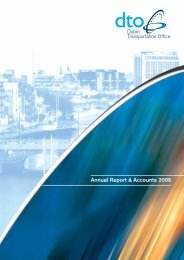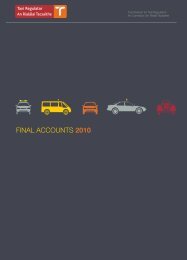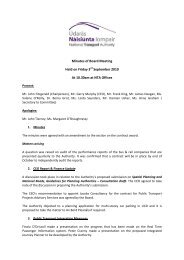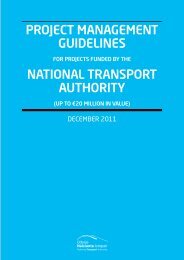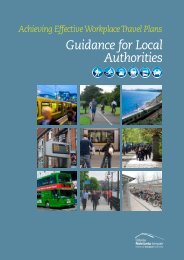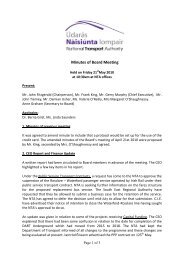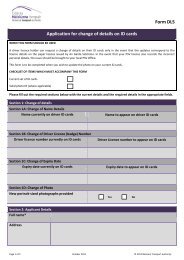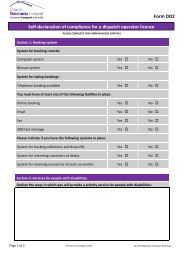Greater Dublin Area Draft Transport Strategy 2011-2030
Greater Dublin Area Draft Transport Strategy 2011-2030
Greater Dublin Area Draft Transport Strategy 2011-2030
- No tags were found...
Create successful ePaper yourself
Turn your PDF publications into a flip-book with our unique Google optimized e-Paper software.
Measure TDM 1:The Authority will evaluate the feasibility andpotential benefits of the following measures tomanage travel demand on roads in the <strong>Greater</strong><strong>Dublin</strong> <strong>Area</strong>, and where appropriate seek theirimplementation:• Ramp Metering, variable speed limits orhard shoulder running on dual carriagewaysor motorways, at times and places wherecongestion on these strategic roads isaffecting journey time reliability anddisrupting traffic flows;• Dedication of traffic lanes to particulartransport modes such as public transportlanes or freight lanes on certain roads, inaddition to bus priority provision whereappropriate (see section 11.3.2); and• Introduction or expansion of local authorityon-street parking controls that seek toreduce commuter parking.Parking charges and leviesParking charges are already extensively applied in<strong>Dublin</strong> city centre and other towns in the <strong>Greater</strong><strong>Dublin</strong> <strong>Area</strong>. It is desirable to charge for parking inthese areas, to increase turnover of spaces, makingit easier for those who need to drive to find aparking space.In addition, the Government announced as part ofBudget 2009 the introduction of a levy in respectof workplace provided parking facilities in majorurban centres, to be specified in regulation by theMinister for Finance.Demand management through a workplace parkinglevy could play a significant role in reducing carcommuting. There is potential for levies to beextended to other types of destinations such asout-of-town shopping centres. For the measure tobe most effective, a mechanism is required thatcharges the individual user of the space each timethe space is used.Measure TDM 2:The Authority will:• Support the introduction or expansionof charging for on-street car parking inareas where space is scarce and chargingcontributes to parking turnover;• Support the introduction of a levy onoff-street parking spaces at town andemployment centres and out-of-downretail developments subject to evaluationof feasibility and benefits and any necessarylegislative change; and• Support the setting of parking chargesat levels to achieve specific transportobjectives.Road access control, parking restrictions andparking charges address issues due to excessdemand on individual roads or individual corridors.They are less appropriate for managing traveldemand on wider geographical or regional basis.In this case, road user charging is the mostappropriate and effective mechanism to use. It isdesigned to influence people’s decision to makea journey by car, and encourage them to consideralternative modes to the car when they do travel.Road use chargingRoad use charging spans a range of possibilities fromrelatively simple single toll point charging to moreelaborate area based or route charging schemesusing satellite tracking systems or Dedicated ShortRange Communication (DSRC) systems.Road use charging already operates extensively inIreland with toll plazas on ten routes throughoutthe country (nine national roads and one nonnationalroad) as well as an electronic barrier-freetolling operation on the M50 motorway. Oneof those toll routes – the <strong>Dublin</strong> Port Tunnel –operates a variable rate tolling system whichapplies a higher toll charge during peak hours thanthe charge prevailing in the off-peak hours.Chapter 11: page 14 www.<strong>2030</strong>vision.ie




